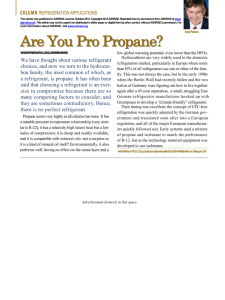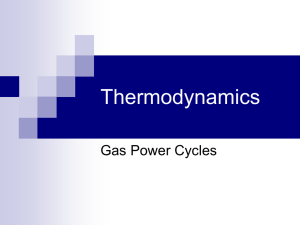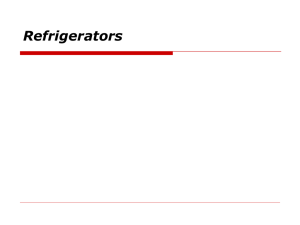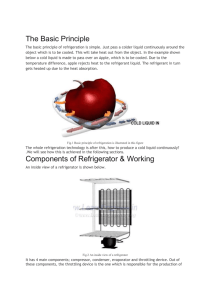Vapor-Compression Refrigeration: Cycle Analysis & Thermodynamics
advertisement
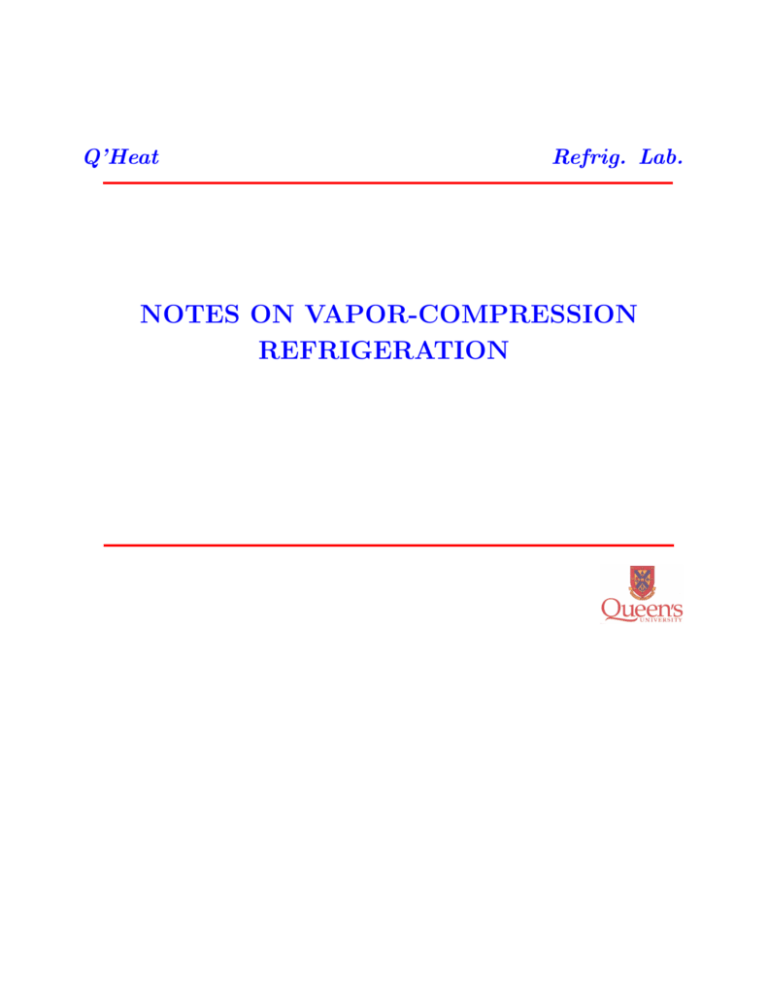
Q’Heat Refrig. Lab. NOTES ON VAPOR-COMPRESSION REFRIGERATION Q’Heat Refrig. Lab. Introduction The purpose of this lecture is to review some of the background material required to undertake the refrigeration laboratory. The Thermodynamics of the basic refrigeration cycle will be reviwed and some aspects of of simple heat exchanger modelling will be discussed. Q’Heat Refrig. Lab. A refrigerator is a machine that removes heat from a low temperature region. Since energy cannot be destroyed, the heat taken in at a low temperature must be dissipated to the surroundings. The Second Law of Thermodynamics states that heat will not pass from a cold region to a warm one without the aid of an “external agent”. Therefore, a refrigerator will require this “external agent”, or energy input, for its operation. Q’Heat A refrigeration system. Refrig. Lab. Q’Heat Refrig. Lab. The most common refrigeration system in use today involves the input of work (from a compressor) and uses the Vapor Compression Cycle. The purpose of these notes is to introduce some important features of this type of refrigeration system and to discuss how such systems can be thermodynamically modeled. In a vapor compression refrigeration system a gas is alternatively compressed and expanded and goes from the liquid to the vapor state. The basic components of a vapor-compression refrigeration system are shown below. Q’Heat Refrig. Lab. A vapor-compression refrigeration system.. The characteristics of this gas must be chosen to match the use to which the system is to be put. This gas is referred to as the refrigerant. Q’Heat Refrig. Lab. Coefficient of Performance The purpose of the refrigerator is to remove heat from the cold region while requiring as little external work as possible. A measure of the efficiency of the device is therefore: Coefficient of Performance (COP) = Rate of heat removal from the cold region Rate work is done = Q̇ Ẇ The COP will here be given the symbol β. If q is the heat removed per unit mass and if w is the work done per unit mass then if ṁ is mass flow rate of the refrigerant, then COP (= β) = ṁq ṁw = q w Q’Heat Refrig. Lab. Vapor-Compression Cycle The Vapor Compression Cycle uses energy input to drive a compressor that increases the pressure and pressure of the refrigerant which is in the vapor state. The refrigerant is then exposed to the hot section (termed the condenser) of the system, its temperature being higher than the temperature of this section. As a result, heat is transferred from the refrigerant to the hot section (i.e. heat is removed from the refrigerant) causing it to condense i.e. for its state to change from the vapor phase to the liquid phase (hence the term condenser). The refrigerant then passes through the expansion valve across which its pressure and temperature drop considerably. The refrigerant temperature is now below that existing in the cold or refrigerated section (termed the evaporator) of the system, its temperature being lower than the temperature in this section. As a result, heat is transferred from the refrigerated section to the refrigerant (i.e. heat is absorbed by the refrigerant) causing it to pass from the liquid or near-liquid state to the vapor state again (hence the term evaporator). The refrigerant then again passes to the compressor in which its pressure is again increased and the whole cycle is repeated. Q’Heat Refrig. Lab. The basic processes in a vapor-compression refrigeration system are therefore as shown below. Vapor-compression refrigeration cycle. Q’Heat Refrig. Lab. The four basic components of the vapour compression refrigeration system are thus: 1. evaporator - Heat is absorbed to boil the liquid at a low temperature, therefore a low pressure must be maintained in this section. 2. compressor - The compressor does work on the system increasing the pressure from that existing in the evaporator (drawing in low- pressure, low-temperature saturated vapour) and to that existing in the condenser (i.e., delivering high pressure and high temperature vapour to the condenser. 3. condenser - The high pressure, high temperature (superheated or saturated) vapour that enters the condenser has heat removed from it and as a results it is condensed back into a liquid phase. 4. throttle valve - The high pressure liquid from the condenser is expanded through this valve, allowing its pressure to drop to that existing in the evaporator. As already mentioned, Vapor-compression refrigeration systems are the most common type of refrigerator in use today. Q’Heat Refrig. Lab. Cycle Analysis If it is assumed that the system is operating at a steadystate and if it is assumed that kinetic and potential energy changes are negligible, the cycle can be analysed in the usual way. The principal work and heat transfer that occurs in the system are shown below, these quantities being taken as positive in the directions indicated by the arrows in this figure. In the analyses, each component is first separately considered. The evaporator, in which the desired refrigeration effect is achieved, will be considered first. A vapor-compression refrigeration system. Q’Heat Refrig. Lab. As the refrigerant passes through the evaporator, heat transfer from the refrigerated space results in the vaporization of the refrigerant. Considering a control volume enclosing the refrigerant side of the evaporator, conservation of mass and energy applied to this control volume together give the rate of heat transfer per unit mass of refrigerant flow in the evaporator as: Q̇in ṁ = h1 − h4 where ṁ is the mass flow rate of the refrigerant. The heat transfer rate to the refrigerant in the evaporator, Q̇in, is referred to as the refrigeration capacity, it usually being express in kW or in Btu/hr or in tons of refrigeration, one ton of refrigeration being which is equal to 200 Btu/min or about 211 kJ/min. Q’Heat Refrig. Lab. Next consider the compressor. The refrigerant leaving the evaporator is compressed to a relatively high pressure and temperature by the compressor. It is usually adequate to assume that there is no heat transfer to or from the compressor. Conservation of mass and energy rate applied to a control volume enclosing the compressor then give: Ẇ = h2 − h1 ṁ where Ẇ /ṁ is the work done per unit mass of refrigerant. Q’Heat Refrig. Lab. Next, the refrigerant passes through the condenser, where the refrigerant condenses and there is heat transfer from the refrigerant to the cooler surroundings. For a control volume enclosing the refrigerant side of the condenser, the rate of heat transfer from the refrigerant per unit mass of refrigerant is Q̇out ṁ = h2 − h3 Q’Heat Refrig. Lab. Finally, the refrigerant at state 3 enters the expansion valve and expands to the evaporator pressure. This process is usually modeled as a throttling process in which there is no heat transfer, i.e., for which h4 = h3 In this valve the refrigerant pressure decreases in an irreversible adiabatic process and there is an accompanying increase in entropy. The refrigerant leaves the valve at state 4 as a two-phase liquid-vapor mixture. Q’Heat Refrig. Lab. In the vapor-compression system, the net power input is equal to the compressor power, the expansion valve involving no power input or output. Using the quantities and expressions introduced above, the coefficient of performance, β, of the vapor- compression refrigeration system is given by: β = Q̇in /ṁ ẆC /ṁ = h1 − h4 h2 − h1 Q’Heat Refrig. Lab. Provided states 1 through 4 are prescribed, the above equations can be used to evaluate the principal work and heat transfer and the coefficient of performance of the vapor-compression system. Since these equations have been developed by using conservation of mass and energy, they can be used to predict the actual performance of a real system when irreversibilities are present in the evaporator, compressor, and condenser and to predict the performance of an idealized system in which such effects are absent. Although irreversibilities in the evaporator, compressor, and condenser can have a pronounced effect on overall performance of the system, much is to be gained by considering an idealized cycle in which such irreversibilities are assumed absent. Such a cycle establishes an upper limit on the performance of the vapor-compression refrigeration cycle. Such an idealized cycle is considered in the next section. Q’Heat Refrig. Lab. Ideal and Actual Vapor-Compression Cycles An ideal refrigeration cycle is first considered. In this case irreversibilities within the evaporator, compressor, and condenser are ignored, it is assumed that frictional pressure drops in the system are negligible and that the refrigerant flows at constant pressure through the two heat exchangers, i.e., through the condenser and through the evaporator and that all heat transfer to the surroundings is negligible. With these assumptions, the compression process will be isentropic. The ideal vaporcompression refrigeration cycle, labeled 1-2s-3-4-1, on the temperature-entropy, i.e. T-s, diagram is as shown before. Vapor-compression refrigeration cycle. Q’Heat Refrig. Lab. This cycle consists of the following series of processes: Process 1-2s: Isentropic compression of the refrigerant from state 1 at the exit of the evaporator to the condenser pressure at state 2s. Process 2s-3: Heat transfer from the refrigerant occurs as the refrigerant flows at constant pressure through the condenser. The refrigerant exits as a liquid at state 3. Process 3-4: Throttling process from state 3 to a twophase liquid-vapor mixture at 4 occurs at constant enthalpy. Process 4-1: Heat transfer to the refrigerant occurs as it flows at constant pressure through the evaporator to complete the cycle. Q’Heat Refrig. Lab. All of the processes in the above cycle are internally reversible except throttling process. Despite the inclusion of this irreversible process, the cycle is normally referred to as the ideal cycle. The ideal cycle is often taken to involve a saturated vapor, state 1’, at the compressor inlet and a saturated liquid, state 3’, at the condenser exit, this cycle being shown in below. Q’Heat “Ideal”Vapor-compression refrigeration cycle. Refrig. Lab. Q’Heat Refrig. Lab. The operating temperatures of the vapor-compression refrigeration cycle are established by the temperature TC to be maintained in the cold region and the temperature TH of the warm region to which heat is discharged. As pointed out earlier, refrigerant temperature in the evaporator must be less than TC and the refrigerant temperature in the condenser must be greater than TH . Q’Heat Refrig. Lab. Shown in the following figure (same as given earlier)the actual cycle 1-2-3-4-1 differs in a key way from that of the ideal cycle. Vapor-compression refrigeration cycle. Q’Heat Refrig. Lab. This difference is the departure from an isentropic process due to internal irreversibilities present during the actual compression process. The actual process is indicated schematically by the dashed line for the compression process from state 1 to state 2. This dashed line shows the increase in specific entropy that would accompany an adiabatic irreversible compression. However, if sufficient heat transfer occurred from the compressor to its surroundings, the specific entropy at state 2 could be less than at state 1. Comparing cycle 1-2-3-4-1 with the corresponding ideal cycle 1- 2s-3-4-1, it will be seen that the refrigeration capacity is the same for each, but the work input is greater the case of irreversible compression than in the ideal cycle. Accordingly, the coefficient of performance of cycle 1-2-3-4-1 is less than that of cycle 1-2s-3-4-1. Q’Heat Refrig. Lab. The effect of irreversible compression can be accounted for by using the isentropic compressor efficiency, ηC , which, for the refrigerant states indicated in the previous figure, is given by: ηC = (ẆC /ṁ)s ẆC /ṁ = h2s − h1 h2 − h1 Additional departures from ideal cycle stem from frictional effects that result in pressure drops as the refrigerant flows through the evaporator, condenser, and the piping connecting the various components in the system. These pressure drops are usually ignored. Q’Heat Refrig. Lab. Refrigerant Properties The temperatures of the refrigerant in the evaporator and condenser are the temperatures of the cold and warm regions, respectively, with which the system interacts thermally. This, in turn, determines the operat- ing pressures in the evaporator and condenser. Consequently, the selection of a refrigerant is based partly on the suitability of its pressure-temperature relationship in the range of the particular application. It is generally desirable to avoid excessively low pressures in the evaporator and excessively high pressures in the condenser. Other considerations in refrigerant selection include chemical stability, toxicity, corrosiveness, and cost. The type of compressor used also affects the choice of refrigerant. Centrifugal compressors are best suited for low evaporator pressures and refrigerants with large specific volumes at low pressure. Reciprocating compressors perform better over large pressure ranges and are better able to handle low specific volume refrigerants. Other considerations in refrigerant selection include chemical stability, toxicity, corrosiveness, and cost. Q’Heat Refrig. Lab. A thermodynamic property diagram widely used in the refrigeration field is the pressure-enthalpy or p-h diagram. The following figure shows the main features of such a property diagram. Pressure-Enthalpy (p-h) diagram. The principal states of the vapor-compression cycles discussed before are indicated on this p-h diagram. Property tables and p-h diagrams for many refrigerants are given in handbooks dealing with refrigeration. Q’Heat Refrig. Lab. Overall Heat Transfer Coefficient In the evaporator and condenser, heat is transferred between the refrigerant and the surrounding fluid. The evaporator and condenser are examples of a heat exchanger which is a device designed to transfer heat from one fluid to another fluid, the fluids both flowing through the heat exchanger and the fluid streams being separated by the solid walls of the heat exchanger. The layout of a simple “shell-in-tube”is shown in the following figure. Q’Heat Shell-in-Tube heat exchanger. Refrig. Lab. Q’Heat Refrig. Lab. As the fluids pass through the heat exchanger their temperatures change and it is usual to express the rate of heat transfer from the hot fluid to the cold fluid, Q̇, by an equation of the form: Q̇ = U A (Thot − Tcold ) Here U is termed the overall heat transfer coefficient, A is the area of the surface separating the fluids through which the heat transfer occurs and (Thot − Tcold) is the mean differences between the temperatures of the two fluids. Q’Heat Refrig. Lab. It can be shown that if U is assumed constant, the mean temperature difference that should be used is the socalled log. mean temperature difference, θLM T . Consider the temperature variations of the fluids as they pass through the heat exchanger as shown schematically below: Fluid temperature variation through heat exchanger. Q’Heat Refrig. Lab. If θi is the difference between the temperatures of the hot and cold fluids at the inlet to the heat exchanger and if θo is the difference between the temperatures of the hot and cold fluids at the outlet to the heat exchanger the log mean temperature difference is given by: θLM T = θi − θo ln(θi /θo ) The heat transfer rate is then given by: Q̇ = U A θLM T Q’Heat Refrig. Lab. It should also be noted that since a steady state is being assumed: Q̇ = Rate of heat transfer from hot fluid = Rate of heat transfer to cold fluid = ṁH (hHi − hHo) = ṁC (hCo − hCi) The subscripts H and C referring to the hot and cold fluid streams respectively and the subscripts i and o referring to inlet and outlet conditions respectively. Q’Heat Layout of experimental apparatus. Refrig. Lab. Q’Heat Refrig. Lab. The system uses R-141b as a refrigerant. Properties of this refrigerant are given in the figures, one giving the relation between the saturation temperature and the saturation pressure while the other gives a p-h diagram. Q’Heat Refrig. Lab. Saturation temperature and the saturation pressure diagram for R-141b. Q’Heat p-h diagram for R-141b. Refrig. Lab. ASSIGNMENT 1. Assume that a vapor-compression refrigeration system operates at a steady state and on an ideal refrigeration cycle using Refrigerant 134a as the working fluid. Saturated vapor enters the compressor at -10o C and saturated liquid leaves the condenser at 28o C. The mass flow rate of the refrigerant is 5 kg/min. Find: a. The compressor power in kW. b. The refrigerating capacity in tons. c. The coefficient of performance. Tables giving the properties of R134a are attached. 2. A vapor-compression refrigeration system operates at a steady state and uses Refrigerant 134a as the working fluid. The mass flow rate of the refrigerant is 6 kg/min. The vapor enters the compressor at a temperature of -10o C and a pressure of 1.4 bar and leaves at a pressure of 7 bar. The isentropic compressor efficiency is 67%. The refrigerant leaves the condenser at a temperature of 24o C and a pressure of 7 bar. Pressure drops in the condenser and evaporator and in the connecting piping can be neglected as can any heat transfer between the system and its surroundings. Find: a. The refrigerating capacity in tons. b. The coefficient of performance. In finding the thermodynamic properties of the refrigerant, it can be assumed that the enthalpy of the subcooled liquid refrigerant depends only on the temperature, i.e. that h for the sub-cooled liquid is equal to h for the saturated liquid at the same temperature. 3. A heat exchanger is used to heat air from an inlet temperature of 0o C to an exit temperature of 30o C using water which enters the heat exchanger at a temperature of 60o C and leaves the heat exchanger at a temperature of 50o C, the process being shown in the following figure: The mass flow rate of air through the heat exchanger is 0.007 kg/s. Find: a. The mass flow rate of water. b. The log. mean temperature difference. c. The heat transfer area. In finding the required enthalpy changes it can be assumed for air that: (hb − ha )air J/kg = 1005 (Tb − Ta ) o T being in C, and that for water: (hb − ha )water J/kg = 4180 (Tb − Ta ) o T again being in C. 11



